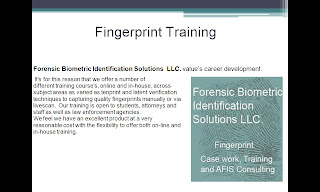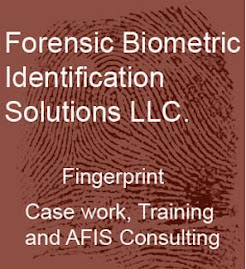Bob McAuley Dir. Operations/Training Forensic Biometric Identification Solutions LLC.
Friday, September 9, 2011
Latent Fingerprint Documentation and Case Note Practices
Bob McAuley Dir. Operations/Training Forensic Biometric Identification Solutions LLC.
Monday, August 15, 2011
Accuracy of the Automated Fingerprint Identification System and Latent Examiners
Bob McAuley Dir. Operations/Training Forensic Biometric Identification Solutions LLC.
Wednesday, July 27, 2011
No Value(Inconclusive) Latent Images
Click on the image above to go to the presentation, if you have any questions please contact us.
Bob McAuley Dir. Operations/Training Forensic Biometric Identification Solutions LLC.
Bob McAuley Dir. Operations/Training Forensic Biometric Identification Solutions LLC.
Sunday, July 17, 2011
Questions You May Find Useful in a Case That Involves Unidentified Latent Images
Click on the image above to go to the presentation.
Bob McAuley Dir. Operations/Training Forensic Biometric Identification Solutions LLC.
Bob McAuley Dir. Operations/Training Forensic Biometric Identification Solutions LLC.
Monday, July 11, 2011
Medical Issue's Impacting Fingerprint Accuracy
When attention is paid to missed and bad identifications the errors are usually attributed to a lack of knowledge, failure to follow ACE-V or a clerical error. There is very little mention of physical problems that might compromise a persons visual acuity.The reason I bring this up is that very few agencies require vision examinations for employee's on a regular basis. The CDC has been estimated that in 2005 diabetes effected 14.6 million persons in the U.S. with an additional 6.2 million undiagnosed individuals. One of the effects of diabetes is diabetic retinopathy.
The National Institute of Health has indicated that 40-45 percent of Americans diagnosed with diabetes already have some stage of diabetic retinopathy. It's possible to have diabetic retinopathy and not know it. In fact, it's uncommon to have symptoms in the early stages of diabetic retinopathy. As the condition progresses,symptoms can include,blurred vision,fluctuating vision,dark or empty areas, impaired color vision, vision loss. As is clear this condition could lead to a missed or bad identification.
I did look at the SWGFAST Standards for Minimum Qualifications and Training to Competency
for Friction Ridge Examiners (Latent/Tenprint) but doesn't look at visual acuity. I would suggest that an agency have latent or tenprint examiners vision tested on a regular basis to insure accurate fingerprint analysis.
Bob McAuley Dir. Operations/Training Forensic Biometric Identification Solutions LLC.
Tuesday, June 14, 2011
Advantages to On-Line Fingerprint Training Programs
Advantages to On-Line Fingerprint Training Programs
Please take a minute to look at the advantages of our on-line fingerprint training course. The training is invaluable to anyone entering the forensic identification field.
Bob McAuley Dir. Operations/Training Forensic Biometric Identification Solutions LLC.
Please take a minute to look at the advantages of our on-line fingerprint training course. The training is invaluable to anyone entering the forensic identification field.
Bob McAuley Dir. Operations/Training Forensic Biometric Identification Solutions LLC.
Thursday, February 10, 2011
Analysis, Comparison, Evaluation & Verification (ACE-V) and the Scientific Method
Recently I reviewed some testimony of a some fingerprint examiners where they explained the fingerprint verification process they used to come to their conclusion. What struck was the explanation of the process was cryptic and did not reference the scientific method that allows us to make our comparison decisions. If I were a juror or an officer of the court with limited knowledge of fingerprints the explanation of the verification process would sound more like a procedure than science. In Vol. 60 of the Journal of Forensic Identification there is a very good article from the FBI Latent Unit at Quantico that describes the fingerprint comparison process and its relationship to the scientific method. The reason that I feel this is so important is that if the examiner understands the scientific method and how ACE-V is incorporated in the process will enhance the examiners ability to explain the process to the jurors and the court.
The scientific method is the process used by scientists, a systematic pursuit of knowledge involving the recognition and forming of a problem, the collection of data through observation and experiment and the testing of ideas and theories by using experiments and careful observation.
The observations made are friction skin develops on the fetus and is persistent throughout life , friction skin is unique and finally ridge patterns vary within limits which allows for pattern classification. Based on the above it can be theorized that friction skin can be individualized our hypothesis.
The Analysis (A) and Comparison (C) of our minutiae would be the experimentation required in the scientific method.
The Evaluation (E) and comparison decision would be the Conclusion in the scientific method.
The Verification (V) validating the original decision by another examiner would confirm the process and conclusions required in the scientific method.
The recording of the details of the process should be recorded in the case folder or the electronic case record.
This is a much more professional way to explain the ACE-V process.
Bob McAuley Dir. Operations/Training Forensic Biometric Identification Solutions LLC.
The scientific method is the process used by scientists, a systematic pursuit of knowledge involving the recognition and forming of a problem, the collection of data through observation and experiment and the testing of ideas and theories by using experiments and careful observation.
The observations made are friction skin develops on the fetus and is persistent throughout life , friction skin is unique and finally ridge patterns vary within limits which allows for pattern classification. Based on the above it can be theorized that friction skin can be individualized our hypothesis.
The Analysis (A) and Comparison (C) of our minutiae would be the experimentation required in the scientific method.
The Evaluation (E) and comparison decision would be the Conclusion in the scientific method.
The Verification (V) validating the original decision by another examiner would confirm the process and conclusions required in the scientific method.
The recording of the details of the process should be recorded in the case folder or the electronic case record.
This is a much more professional way to explain the ACE-V process.
Bob McAuley Dir. Operations/Training Forensic Biometric Identification Solutions LLC.
Tuesday, January 11, 2011
AFIS Accuracy and the Unidentified Latent Image
In this Blog I wanted to talk about something that would be just as useful to a prosecutor as to a defense attorney. I decided to talk about the automated fingerprint identification system and peoples assumptions of AFIS systems accuracy and potential case impact If you have latent image(s) in a case that are not identified and have been searched in AFIS, can you be sure the individual is not in the system? The answer unfortunately is no. In Omaha a couple years back a latent examiner made a latent identification on a homicide from an AFIS search, I think it may have been the 4 th. search of the system before it produced the correct suspect. The examiner understood that in some cases the latent needs to be entered and searched more than once. So if there are unidentified latents in a case, a single search of the system may not produce the identification. It would seem that in cases going to trial, the attorney would want to insure the unidentified latents be entered more than one(1) time to insure that the latent is one that does not have a match in the database What are some of the causes of the system not producing the individual?
The common assumption of the court, attorneys, jurors and many latent examiners is; AFIS systems are close to 100% accurate, so one search should suffice. Most systems today will have an accuracy less than 75 t0 80 % for latent searches. Typically the vendor will produce an accuracy 75 to 80 % if the latent image has 15 points and the target has the same 15 points. The other thing to remember about these tests are the vendor is using a small database that may not accurately reflect the a larger database of the live system. What can add to the confusion is the tenprint to tenprint accuracy which for the FBI IAFIS is 98% and most state systems probably 95%.
The other factor to remember is the system will produce a number of very good suspects which can move the suspect down the list or when dealing with poor quality images an examiner may miss the identification.
Bob McAuley Dir. Operations/Training Forensic Biometric Identification Solutions LLC.
The common assumption of the court, attorneys, jurors and many latent examiners is; AFIS systems are close to 100% accurate, so one search should suffice. Most systems today will have an accuracy less than 75 t0 80 % for latent searches. Typically the vendor will produce an accuracy 75 to 80 % if the latent image has 15 points and the target has the same 15 points. The other thing to remember about these tests are the vendor is using a small database that may not accurately reflect the a larger database of the live system. What can add to the confusion is the tenprint to tenprint accuracy which for the FBI IAFIS is 98% and most state systems probably 95%.
The other factor to remember is the system will produce a number of very good suspects which can move the suspect down the list or when dealing with poor quality images an examiner may miss the identification.
Another factor to consider, minutiae placement which is critical to any AFIS search. Minutiae can be selected by the system and manually edited by the examiner or manually selected by the examiner. Anecdotal evidence would suggest manually placing the minutiae will produce a more accurate result. Studies have shown that an examiner may vary slightly on minutiae selection the 2nd. time they see a latent print (table 3).
The results of any of the above could lead to a wrongful conviction and individual not being interviewed who may help in the investigation or an element of doubt in a jurors mind. To insure a proper AFIS search the prosecution should insure that latents that may impact a case if unidentified are searched more than one (1) time when they have their meeting prior to the court date. The defense attorney on the other hand would be the fail safe, insuring that the latent was searched multiple times.
Bob McAuley Dir. Operations/Training Forensic Biometric Identification Solutions LLC.
Subscribe to:
Comments (Atom)





















